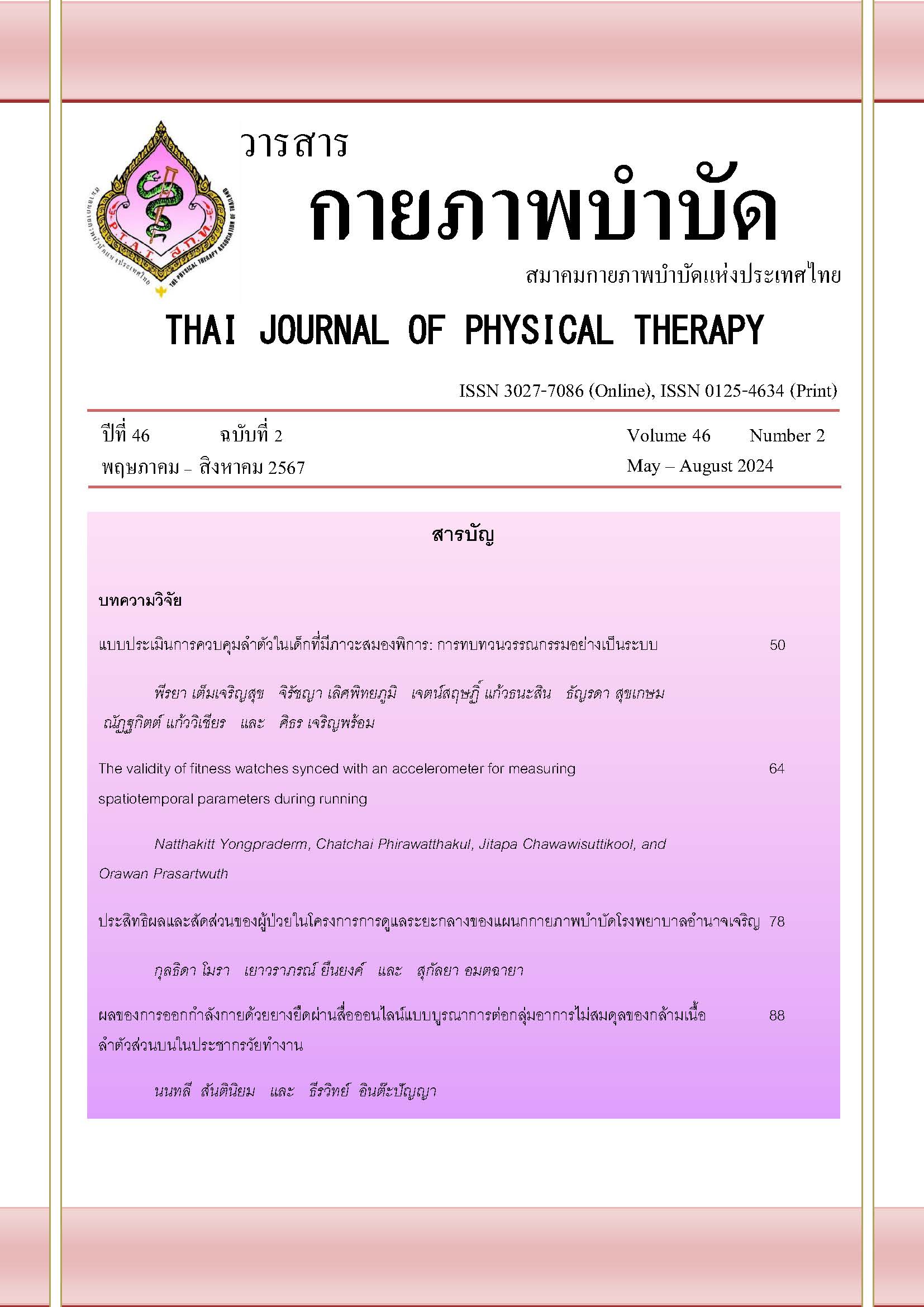แบบประเมินการควบคุมลำตัวในเด็กที่มีภาวะสมองพิการ: การทบทวนวรรณกรรม อย่างเป็นระบบ
Main Article Content
บทคัดย่อ
ที่มาและความสำคัญ: การควบคุมลำตัวบกพร่องเป็นหนึ่งในความผิดปกติที่พบมากในเด็กที่มีภาวะสมองพิการซึ่งส่งผลกระทบโดยตรงต่อความสามารถด้านการเคลื่อนไหวและการทำกิจกรรมทำให้การประเมินการควบคุมลำตัวจึงมีความสำคัญ ปัจจุบันมีการพัฒนาแบบประเมินการควบคุมลำตัวเพื่อใช้ในทางคลินิกหลายเครื่องมือซึ่งมีรายละเอียดและความเหมาะสมของการนำไปใช้แตกต่างกัน การศึกษานี้จึงมีขึ้นเพื่อเป็นประโยชน์ในการพิจารณาเลือกใช้แบบประเมินได้ตรงตามความต้องการต่อไป
วัตถุประสงค์: เพื่อรวบรวมข้อมูลแบบประเมินการควบคุมลำตัวในเด็กที่มีภาวะสมองพิการที่มีการเผยแพร่ในปัจจุบันอย่างเป็นระบบ
วิธีการวิจัย: สืบค้นงานวิจัยที่ศึกษาแบบประเมินการควบคุมลำตัวจากแหล่งข้อมูลออนไลน์ทั้งหมด 7 แหล่ง และทำการคัดกรองตามเกณฑ์การคัดเข้าและคัดออก จากนั้นนำงานวิจัยที่เข้ารอบมาสกัดข้อมูลออกเป็นหมวดหมู่ ได้แก่ (1) จุดประสงค์ของแบบประเมิน, (2) การนําไปใช้ทางคลินิก, (3) การออกแบบเครื่องมือการประเมิน, และ (4) คุณลักษณะของกลุ่มตัวอย่างที่ทำการศึกษา
ผลการวิจัย: งานวิจัยที่คัดเข้าทั้งหมด 12 งานวิจัย แบ่งได้เป็น 3 แบบประเมิน ได้แก่ Segmental Assessment of Trunk Control (SATCo), Trunk Impairment Scale (TIS), และ Trunk Control Measurement Scale (TCMS) ทั้ง 3 แบบประเมินถูกออกแบบมาเพื่อประเมินการควบคุมลำตัวเป็นหลักโดยมีคุณลักษณะเฉพาะที่แตกต่างกันและมีค่าความน่าเชื่อถือที่หลากหลายในระดับดีถึงดีมาก
สรุปผล: SATCo, TIS, และ TCMS มีวัตถุประสงค์และการนำไปใช้ที่แตกต่างกัน TIS และ TCMS เหมาะสำหรับการประเมินในเด็กที่สามารถนั่งทรงตัวและให้ความร่วมมือได้ในระดับหนึ่ง เช่น มีระดับ Gross Motor Function Classification System (GMFCS) I-III หรือสามารถทำตามคำสั่งการทดสอบได้ ในขณะที่ SATCo ใช้ประเมินได้ในทุกระดับความสามารถ รวมถึงกลุ่มที่ไม่สามารถควบคุมลำตัวหรือมีข้อจำกัดเรื่องความเข้าใจได้ ทั้ง 3 แบบประเมินใช้เวลาในการทดสอบน้อย เข้าถึงง่าย และมีค่าความน่าเชื่อถือเหมาะสมกับการนำไปใช้ในทางคลินิก ทั้งนี้ผู้ที่สนใจใช้แบบประเมินควรมีการฝึกและทดสอบหาความน่าเชื่อถือของผู้วัดก่อนนำไปใช้ในคลินิก
Article Details

อนุญาตภายใต้เงื่อนไข Creative Commons Attribution-NonCommercial-NoDerivatives 4.0 International License.
เอกสารอ้างอิง
Patel DR, Neelakantan M, Pandher K, Merrick J. Cerebral palsy in children: a clinical overview. Transl Pediatr. 2020;9(Suppl1):S125-35.
Rosenbaum P, Paneth N, Leviton A, Goldstein M, Bax M, Damiano D, et al. A report: the definition and classification of cerebral palsy April 2006. Dev Med Child Neurol Suppl. 2007;109:8-14.
Panibatla S, Kumar V, Narayan A. Relationship between trunk control and balance in children with spastic cerebral palsy: a cross-sectional study. J Clin Diagn Res. 2017;11(9):YC05-08.
Karthikbabu S, Krishna Rao B, Natarajan M, Solomon J, Mahabala C, Nayak A. Role of trunk rehabilitation on trunk control, balance and gait in patients with chronic stroke: a pre-post design. Neuroscience & Medicine. 2011;2:61-7.
Monica S, Nayak A, Joshua AM, Mithra P, Amaravadi SK, Misri Z, et al. Relationship between trunk position sense and trunk control in children with spastic cerebral palsy: a cross-sectional study. Rehabil Res Pract. 2021: 9758640.
Yildiz A, Yildiz R, Elbasan B. Trunk control in children with cerebral palsy and its association with upper extremity functions. J Dev Phys Disabil. 2018;30:669–76.
Balzer J, Marsico P, Mitteregger E, van der Linden ML, Mercer TH, van Hedel HJA. Influence of trunk control and lower extremity impairments on gait capacity in children with cerebral palsy. Disabil Rehabil. 2018;40(26): 3164-70.
Law M, Macdermid J. Evidence-based rehabilitation: a guide to practice. Thorofare, NJ: SLACK Incorporated; 2008.
Butler PB, Saavedra S, Sofranac M, Jarvis SE, Woollacott MH. Refinement, reliability, and validity of the segmental assessment of trunk control. Pediatr Phys Ther. 2010;22(3):246-57.
Hansen L, Erhardsen KT, Bencke J, Magnusson SP, Curtis DJ. The reliability of the Segmental Assessment of Trunk Control (SATCo) in children with cerebral palsy. Phys Occup Ther Pediatr. 2018;38(3):291-304.
Tedla JS, Reddy RS. Evaluation of psychometric properties of the Segmental Assessment of Trunk Control (SATCo) in children with spastic quadriplegic cerebral palsy. Niger J Clin Pract. 2021;24(7):1077-81.
Sæther R, Jørgensen L. Intra- and inter-observer reliability of the Trunk Impairment Scale for children with cerebral palsy. Res Dev Disabil. 2011;32(2):727-39.
Saether R, Helbostad JL, Adde L, Jørgensen L, Vik T. Reliability and validity of the Trunk Impairment Scale in children and adolescents with cerebral palsy. Res Dev Disabil. 2013; 34(7):2075-84.
Pham HP, Eidem A, Hansen G, Nyquist A, Vik T, Sæther R. Validity and responsiveness of the Trunk Impairment Scale and Trunk Control Measurement Scale in young individuals with cerebral palsy. Phys Occup Ther Pediatr. 2016; 36(4):440-52.
Pavão SL, Maeda DA, Corsi C, Santos MMD, Costa C, de Campos AC, et al. Discriminant ability and criterion validity of the Trunk Impairment Scale for cerebral palsy. Disabil Rehabil. 2019;41(18):2199-205.
Dasoju V, Kovela RK, Tedla JS, Sangadala DR, Reddy RS. Psychometric properties of Trunk Impairment Scale in children with spastic diplegia. Sci Rep. 2021;11(1):18529.
Jung H, Choi YE. The psychometric properties of the Trunk Impairment Scale in children with cerebral palsy. Children. 2022;9(3):435.
Heyrman L, Molenaers G, Desloovere K, Verheyden G, De Cat J, Monbaliu E, et al. A clinical tool to measure trunk control in children with cerebral palsy: the Trunk Control Measurement Scale. Res Dev Disabil. 2011; 32(6):2624-35.
Mitteregger E, Marsico P, Balzer J, van Hedel HJ. Translation and construct validity of the Trunk Control Measurement Scale in children and youths with brain lesions. Res Dev Disabil. 2015;45-46:343-52.
Ravizzotti E, Vercelli S, Pellicciari L, Furmanek MP, Zagnoni G, Piscitelli D. Reliability and validity of the Trunk Control Measurement Scale among children and adolescents with cerebral palsy in Tanzania. Percept Mot Skills. 2021; 128(2):731-45.
Portney LG, Watkins MP. Foundations of clinical research: applications to practice. 2nd ed. New Jersey: Prentice-Hall, Inc.; 2000.
Surveillance of Cerebral Palsy in Europe (SCPE). Prevalence and characteristics of children with cerebral palsy in Europe. Dev Med Child Neurol. 2002;44(9):633-40.


